How and what is better to close the heating battery: options for masking radiators
Unfortunately, the appearance of even the most modern heating devices does not always meet aesthetic requirements, and sometimes it can not fit perfectly into the interior of the room. The desire of the owners to eliminate this drawback is quite natural.
Before you close the heating battery, you should understand all the intricacies of the issue. Otherwise, housing heating costs can increase significantly. In our material we will tell you how to do this without any special financial costs and heat loss.
The content of the article:
Disguise of radiators and laws of heat engineering
The main task of any heating radiator is to heat the room. The goal is achieved by a combination or separate use of two methods - infrared radiation and convection. Thanks to them, comfortable conditions are formed. Infrared radiation provides heat transfer to objects in the room, convective - heats the air.
We can feel thermal energy if we place our hand in the immediate vicinity of the radiator. Convection provides air circulation and even distribution of temperature throughout the room. This is also known from the course of school physics - warm air, rising up, displaces colder.
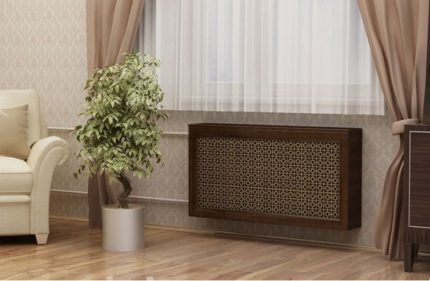
You need to understand that almost any pipe concealment method and radiators will lead to an inevitable loss of heating power. The simplest example is the use of a glass screen with artistic painting.
It would seem that the task of decorating the radiator was completed successfully, but the room became immediately noticeably colder. It all happened because glass almost completely eliminates infrared radiation.
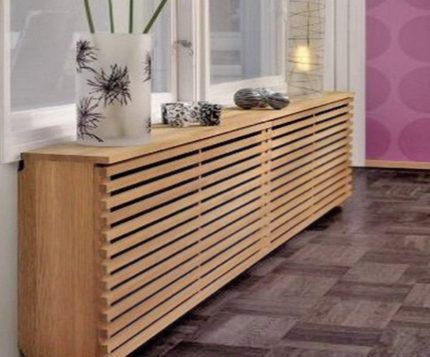
The deeper and more securely the radiator is hidden, the greater the loss.
This statement fully applies to dull screens, which interfere with both long-wave infrared radiation and short-wave convection.
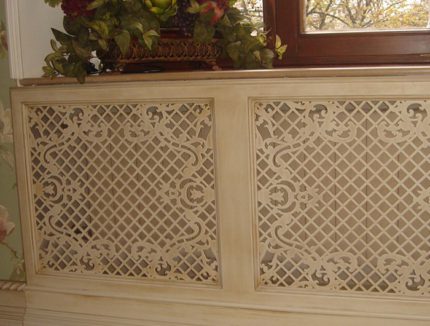
The same can be said about the deaf ducts above the upper part of the radiator - they are an insurmountable barrier to the spread of warm air up (the convection method does not work). The conclusion suggests itself - the larger the area of the holes in the patch, the smaller the heat loss.
Original ideas on the decor and camouflage of heating appliances will be presented by a photo selection:
Requirements for the decor of heating radiators
The availability of pipes and batteries is another important point in choosing a decor after the requirements of heating technology. It is well known that a heating battery, and a nominal connection with a pipe, is the weakest point. In addition, the radiator itself, due to improper installation and operation, or for a number of other reasons, can leak.
In urgent cases, it may be necessary that remove the radiator for repair or replacements. From the point of view of plumbing, the overlay or screen should not have a fixed mount, ideally the use of attached screens.
Even if you decide to neglect the plumber's advice, still listen to the gloss of reason, which suggests that the connection nodes are any weak point in the system. The presence of a revision (plastic door) can greatly simplify the task of servicing the radiator and heating system in the future.
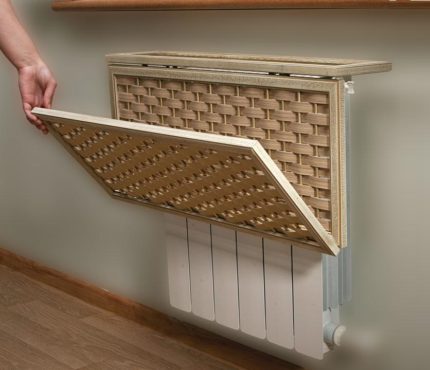
Ways to decorate heating batteries
There are a great many ways to close a heating radiator. To choose the most optimal option, although not easy, is quite possible. Let's start with the simplest and most affordable ways.
Option # 1 - budget painting
From a designer's point of view, color combination is very important. Most often, the heating radiator is painted white; therefore, it will be practically invisible on the walls of light colors.
If the walls have a solid dark color, then there will also be no problems.It will be enough to choose a heat-resistant paint of the desired color and perform radiator painting. If it is not possible to perfectly get into the tone, then there will be nothing to worry about, the difference in several tones against the general background seems almost imperceptible.
If the wallpaper on the walls has a pattern, then the radiator must be made to match it. Most often, one or two walls have an ornament, and the rest are finished with wallpaper of different textures in one tone.
In this case, from the remnants of all the wallpaper used, it is necessary to cut strips and stick them on the radiator. The thickness of the strips and the alternation should be selected on the spot, empirically, trying to fit the resulting pattern most harmoniously into the interior of the room.
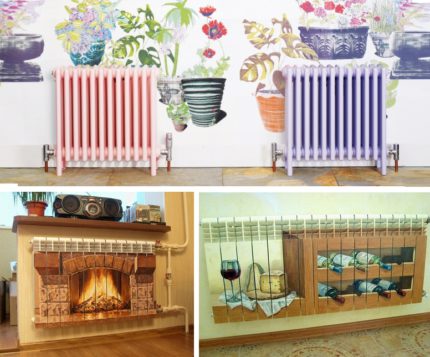
If we are talking about disguising heating radiators in the nursery, then you can give free rein to imagination and paint them to match the surrounding interior. Ready-made stencils will come in handy in case of insufficient experience with the brush. Do not forget that you need to use only heat-resistant paints.
Option # 2 - use of fabric
Another proven and very successful way to mask the heating radiator is the "curtain to the floor." Previously, this method was the simplest and most popular due to the fact that heavy blackout curtains were in fashion. Now it is customary to use dense fabric, which is fastened with Velcro to the wall or window sill.
It is best to fix the curtain from wall to wall, for a light curtain it will look great. This can be done by replacing the curtains with vertical blinds.

Option # 3 - hard screen device
One of the easiest ways to close batteries is to use side shields. For their manufacture can be used in a variety of materials or whole combinations.
True, you need to consider that the screen by the wall itself can look ridiculous, so you need to think through its details to the smallest detail and fit it correctly into the interior. In the store, it will not be difficult to find ready-made screens and close heating radiators with their help.
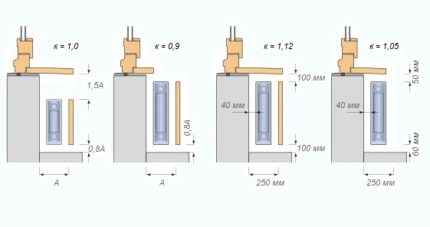
The most widespread are the following types of screens.
Metal screens for batteries
As a rule, stainless steel is used for its manufacture or chrome plating is performed. Such products are characterized by good thermal conductivity and durability.
With a relatively low cost and good functionality, their appearance is poor. Without additional decoration, such screens are suitable for decorating a high-tech room.
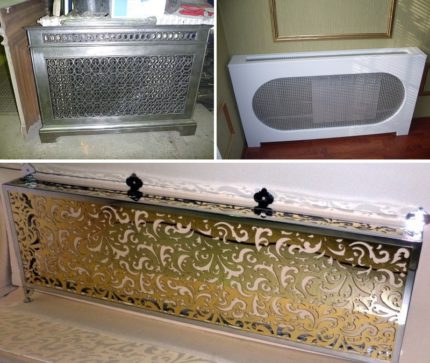
Wooden grill for radiator
This option is considered the most win-win, as the tree easily fits into the interior of almost any room. It’s best not to purchase a ready-made standard screen, but to make it to order. The appearance of the wooden screen must match the style and color of the furniture or be part of it.
The appearance of the wooden screen resembles a wicker lattice and looks impressive and stylish. A wooden grill is best for masking the battery located under the window. Such a design with a sufficient number of holes does not prevent the penetration of warm air and provides good convection.

Decorative glass screen
Decorative glass will give the interior of any room a look of lightness and ease. Rooms with a glass screen made of decorative glass take on the appearance of well-groomed and finished. True, along with a spectacular appearance, such a screen also contains a significant drawback.
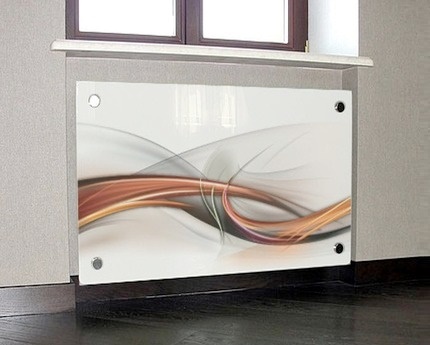
When using a glass screen, heat transfer is almost halved. Therefore, you have to choose between effectiveness and efficiency. If you approach the issue correctly, it is best to use a screen made of decorative glass panels - this will achieve the corresponding hiding effect and ensure maximum thermal conductivity.
Drywall Screen
If earlier it was a question of screens, as finished products, then a gypsum board screen can be made independently. A drywall screen is considered the most budget option. To make it possible for everyone, and fixing with subsequent finishing should not cause special difficulties.
Since the version of the drywall screen device is considered the most universal, we will dwell on its device in more detail. To create and install a screen, you will need the following tools and materials:
- Screwdriver
- Hammer drill
- Stationery knife
- Scissors for metal
- Roulette
- Pencil
- Stapler
- Sandpaper Level
- Drywall Sheet
- Profile CD and UD
- Lattice
Let's open a little secret - drywall is not recommended to be used without preliminary processing. This is due to the fact that this material does not have sufficient thermal conductivity. In addition, under the influence of heat, it collapses and crumbles.
You can correct the situation by processing 2-3 times a sheet of drywall with PVA glue. Such processing will not only effectively prevent drying out, but also significantly increase thermal conductivity.
Work on the installation of a drywall screen begins with the installation of the frame. For its manufacture, it is necessary to cut the guiding UD profiles and fix them with self-tapping screws to the floor and window sill. In order for the screen surface to coincide with the wall surface, the frame must be recessed to the thickness of the drywall plus the thickness of the finish. Usually, this value is 13-14 mm.
Next, you need to fix the CD profiles, while taking into account that the distance between the vertical profiles should slightly exceed the size of the grating. Armed with a pencil and tape measure, you need to put on the sheet the dimensions of the blanks and cut them out with the help of an office knife.

Cut blanks should be screwed to the frame using self-tapping screws. Fastening should be done very carefully, since with excessive deepening of the hats of self-tapping screws, a sheet of drywall can break. It remains to fix the grille and finish the screen.
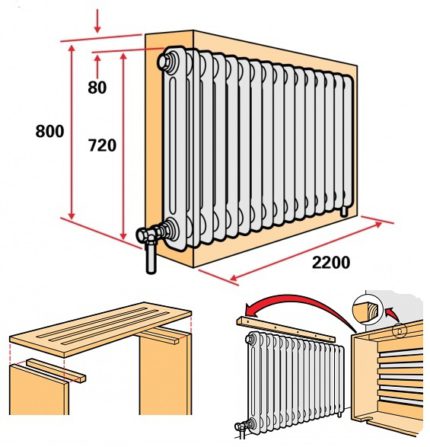
Option # 4 - building battery boxes
Boxes that hide the batteries, it is best to arrange during the repair or installation of the heating system.
The following materials are suitable for making the box:
- Drywall. One of the most common materials. It has a low cost, lightweight and easy to handle. There are many ways to finish using drywall. This material can be puttied and painted, pasted with wallpaper and film, decorated with stucco.
- MDF panels. Another budget option for decorative cladding. MDF is not afraid of sudden changes in temperature and does not dry out. Usually, the design of MDF panels imitates wood of exotic or rare species of wood, which makes it easy to fit into the interior of the room.
- Plywood. This material is very light and easy to handle. With it, you can quickly make a durable and lightweight screen for the radiator. Plywood is easy to cut and also decorated. As finishing, varnishing, painting, gluing a film or wallpaper, decorative plaster can be selected.
- Laminated chipboard sheets. This material is more difficult to work with, although there are never any problems with fixing it.
- Wood. In favor of this material is evidenced by its environmental cleanliness and naturalness. With the help of wooden bars and rails, you can make a wonderful box without working skills and special tools that will help to perfectly close not only the radiator, but also the heating pipes. At the same time, it is much easier to work with rails, especially when working in hard-to-reach places.
A box can become not just a decoration and disguise of a heating battery, but also carry a functional or aesthetic load. If you consider the option with functionality, then you can, for example, using sheets of chipboard and guides to make a cabinet in the entire width of the room.
The optimal height of such a cabinet should correspond to the height of the window sill, if the radiator is located under the window.
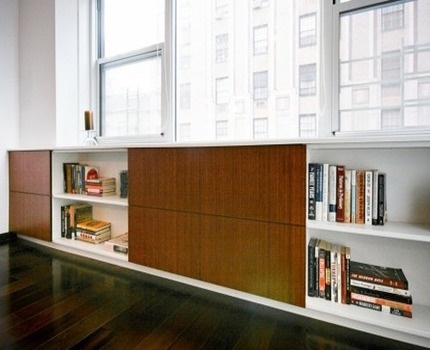
The aesthetic load of the box is more difficult to implement, but is quite feasible. The radiator located near the wall can be decorated under the fireplace. In this case, it is not necessary to use brickwork and the installation of a forged grate. You can do much easier and make a box from a cut sheet of plywood or fiberboard.
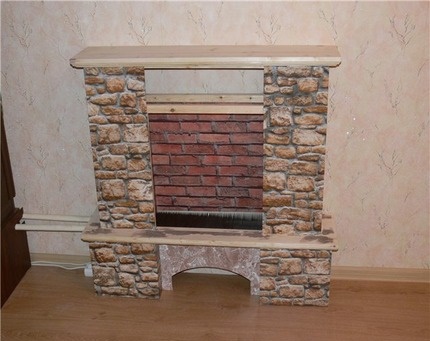
After fixing the wooden rack frame and installing the cut sheets of plywood, it remains to glue the fireplace with a film. You can go further and stick the drawn flame or embers inside the fireplace, everything here depends on the flight of your imagination.
Option # 5 - placing batteries in niches
One of the most laborious methods of masking radiators and heating pipes is implemented at the construction stage or during major repairs. This method assumes the placement of pipes and radiators not on the wall, but inside it.
Of course, this will inevitably lead to a decrease in the useful area of the room and an increase in heat loss, but there is no need to puzzle over how to decorate radiators and heating pipes.
You can go even further and completely abandon radiators and pipes, replacing them with warm floors. If the heating efficiency is insufficient, then it is possible to supplement the heating system with invisible convectors mounted in furniture, window sills, a socle, a floor, etc.
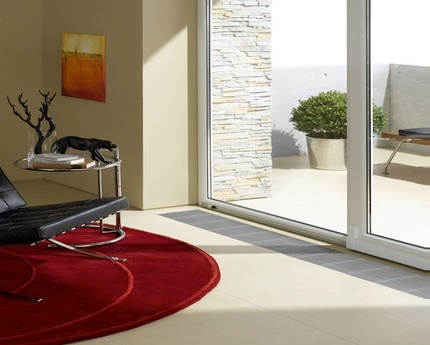
Option # 6 - arrangement of radiators in the bathroom and kitchen
In the bathroom, it is best to hide radiators in any pieces of furniture. Hanging lockers are best suited for this. If for any reason it is not possible to hide the radiator in a cabinet, it is better not to resort to the manufacture of hinged boxes. They will look awkward on the wall. In this case, it’s better to just paint the radiator to match the walls.
As for the placement of the radiator on the floor, you can limit yourself to installing a screen. For the manufacture of the screen, MDF and plastic are suitable, it can also be glass and chromed metal - these materials combine well with the sterile cleanliness and gloss of ceramic tiles.
In the kitchen, radiators are most often masked under the windowsill-countertop. This technique allows not only to hide the radiator, but also significantly increase the working surface. If we are talking about a small-sized apartment, then this technique can be considered a significant bonus. It is already difficult to argue here which aspect is more important - functional or aesthetic.
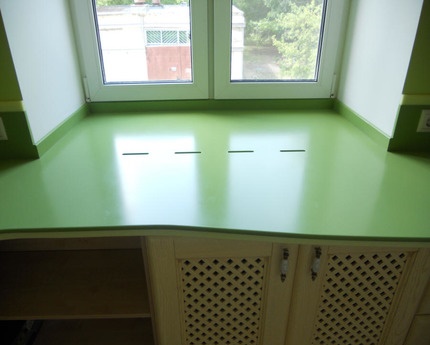
There is another option for installing a folding table. In this case, the color of the countertops and the color of the walls should be the same. The disadvantage of this design is the inability to make the design of the countertop perforated. The presence of a gap between the countertop and the floor, as well as between the countertop and the windowsill, will help ensure normal convection.
Conclusions and useful video on the topic
Video review of masking structures made of decorative glass:
The painting of the heating radiator is shown in the video:
The video will introduce interesting options for decorating heating appliances, the manufacture of which can be handled personally:
When performing masking by any of the proposed methods, do not forget about the main functional task of the heating battery - heating and heat distribution.Incorrectly selected material, installation and decoration scheme can increase heat loss several times.
Do you have questions or have suggestions for masking radiators? Or maybe you yourself built a screen for a heating battery? Please leave your comments or additions to the material in the block below.

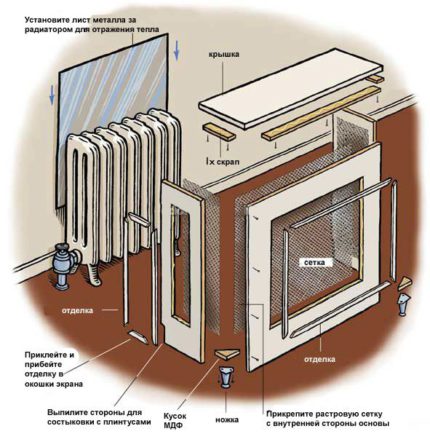
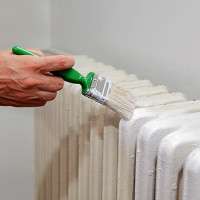 How to paint a heating battery: step-by-step technology for painting radiators
How to paint a heating battery: step-by-step technology for painting radiators 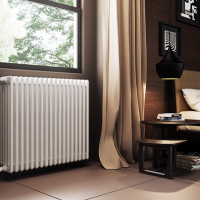 What heating batteries are best for an apartment: classification of radiators and their features
What heating batteries are best for an apartment: classification of radiators and their features 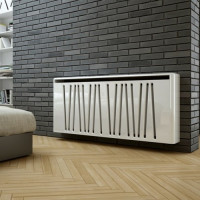 Decorative screens on the heating battery: an overview of the different types of grilles + selection tips
Decorative screens on the heating battery: an overview of the different types of grilles + selection tips 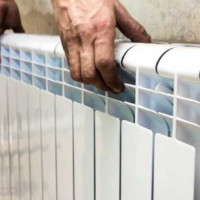 Replacing heating radiators: a guide for dismantling old batteries and installing new appliances
Replacing heating radiators: a guide for dismantling old batteries and installing new appliances 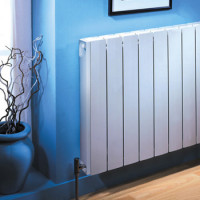 Wiring diagrams for radiators: an overview of the best ways
Wiring diagrams for radiators: an overview of the best ways  How much does it cost to connect gas to a private house: the price of organizing gas supply
How much does it cost to connect gas to a private house: the price of organizing gas supply  The best washing machines with dryer: model rating and customer tips
The best washing machines with dryer: model rating and customer tips  What is the color temperature of light and the nuances of choosing the temperature of the lamps to suit your needs
What is the color temperature of light and the nuances of choosing the temperature of the lamps to suit your needs  Replacement of a geyser in an apartment: replacement paperwork + basic norms and requirements
Replacement of a geyser in an apartment: replacement paperwork + basic norms and requirements
In general, in principle, it is not worthwhile to hide and hide batteries in poorly heated apartments, why not even paint them often, because the heat transfer is significantly impaired. But if the boiler room is warming hot, then you can hide the battery. I prefer to approach this matter without fanaticism, a simple screen is enough. And it’s not necessary to take off easily for dusting and especially to be wiser with a design.
Pretty good ideas for disguising batteries, but most are not even going to hide them in any way, and some even emit them. One option is decoupage and painting. Both that, and another - business troublesome, but very beautiful. You can colorize even the color of the wallpaper, and in the children's room they paint it in special bright pictures to maintain the style. Everyone acts according to desire and opportunity.
Radiator screens are needed only if the room has some special design and the radiator does not fit. For the majority of the population this is an excessive luxury. I believe that in a typical apartment with a normal repair, it is enough to simply paint the heating appliances in a suitable color. In our son’s room, there are yellow walls with a green pattern, the curtains are also green, and the radiator painted the same color. It turned out beautifully.
Someone was closing heating radiators for beauty, and we had a completely different reason. I would even say more compelling. We have two twin boys who only learned to walk and fell constantly. And do not keep track of everything. I am alone with them on the farm for days. I just had a phobia of these batteries. And the batteries are old, cast-iron, solid. A bump is the smallest problem they could bring. I had to close it with a special decorative box made of wood. And I put silicone pads on the corners. It looks beautiful of course, but the heat has become less. But it’s calmer for me that my heads won’t be split. There are also mounted wooden screens, but I only recently noticed them. Also look beautiful.
Hello. The bump is really the smallest problem of the old knee-type heating radiators for families with children. On the remote control of the Ministry of Emergency Situations often receive messages about children stuck in radiators.
It is very difficult without consequences to independently pull out the leg or arm clamped in such a device, especially if the child begins to panic or it happened during the heating season. So, children are one of the most common reasons for deciding to install screens on cast-iron heating radiators.
I still don’t understand what kind of wood can hide batteries from. How should it be processed? Will the heat transfer be high? How many holes should there be?
It is best to choose natural wood screens. Screens are usually made of high-quality material of valuable tree species, for example, oak, alder, beech.For a woman, it may be difficult to make them yourself, but for a man with tools and a day of free time, this is a very real task. In addition to the above listed rocks, aspen is also used, but this is for more sophisticated carpenters. Unfortunately, the price of such wood species is quite high, so most often choose screens from mdf, particleboard.
At the expense of technological holes through which heat will enter the apartment - here you already need to look at the number of sections, the temperature of the radiator and the area of the room. There are no requirements for openings, they can have not only a technological appearance, but more decorative, and even occupy 40% of the frame area. The option, which is considered a classic - 3-4 cm on the sides and a free allowance (depending on the type of radiator), from the wall to the screen, in order to create the optimal air cushion for the circulation of warm air masses.
Here are some examples of wood screen implementations, combined into one photo for convenience.